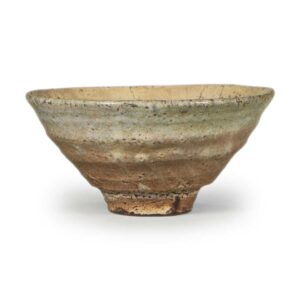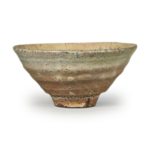

Important Cultural Property
Daimyo-butsu
Held in the collection of the Nezu Museum
Height: 7.1cm
Diameter: 4.3cm
Base diameter: 4.8cm
Height: 1.8cm
In general, Aoido are considered to be inferior pieces, and many of them are thick and heavy, so those that are small, well-made, and have a tight finish with prominent lathe marks are especially prized. The representative work of this type is the Shibata Ido.
The first thing that attracts you to the Shibata Ido is its refreshing shape. The tight, thinly-made, sharp-edged, small-sized shape has four strong, bold lathe marks, and when combined with the tapering shape of the bottom of the tub, which is reminiscent of the joints of bamboo, the sides create a strong rhythm from top to bottom, and it seems as if the shape will reach a peak in a single moment.
The four-stage lathe marks on a well are of course based on the pleasant feeling they give, both visually and to the touch, of the rough and bold rhythm they create. The number of the lathe marks is also related to the speed of the rotation, and the rougher and fewer the marks, the faster the speed and the stronger the sense of power, which also becomes the hidden basis of the aesthetic sense. Wells with too many lathe marks are dull and weak, and lack flavor.
In the case of Shibata, the rough texture of the small-sized pot is strong and prominent, and the pleasantness of the small size is twice or three times more effective than that of the large-sized pot.
The glaze is also wonderful, with a light greenish-yellow color overall and some areas of the glaze pooling with a white tinge. As the name suggests, Aoido is characterized by its bluish glaze, which is due to the fact that the clay used has a higher iron content than Oido, but in rare cases, like Shibata’s, it can have a beautiful light greenish-yellow color that is not inferior to the famous Oido ware. This is another of the outstanding features of Shibata ware. However, compared to Oido ware, Aoido ware has a softer glaze and a more rugged feel.
The sharpness of the foot ring and the rough kaeragi (a type of decoration) that captivates people with its pure white beauty are also features that should not be missed. The inside of the foot ring is well-shaped, and the kaoragi is also beautiful. The tatami mat has five ridges.
There is one lacquered repair on the rim, and there are three to four vertical cracks. There are five eyes on the inside, and the tea pool is deep and pointed at the center, with a well-turned rim.
Truly, like Shibata ware, it is a rare example of a tea bowl that is not only fully equipped with the ten essential qualities, but also has a refined elegance that allows the full enjoyment of the true flavor of the Ido tea bowl. It is not only a famous bowl among Korean and Chinese wares, but can also be praised as one of the best among the many tea bowls.
Inner box: lid, front side, Shunkei lacquer with gold powder lettering “Shibata Ido”
Inside the lid: red lacquer inscription “Transmitted from the Aoyama vassal Asahina, who owned it when Shibata repaired it”
Outside the lid: inscription by Shiro Hirase (Roka’s father) “Ido tea bowl Shibata”
The same is written on the inside of the lid: “Shibata Shuri received from Lord Nobunaga (Hirase seal)”.
It was originally owned by Oda Nobunaga, then passed to Shibata Katsuie, and after his death, it was passed to the Aoyama family retainer Asahina, but later it passed into the hands of the Osaka tea master Chikusa-ya (Hirase family), In 1903, it was sold at auction to the Fujita family, and in 1934, it was sold at auction to Nezu Aoyama (Kaichiro) at the second auction of the Fujita family’s collection, and later, in 1941, it became part of the Nezu Museum collection when the museum was established.








